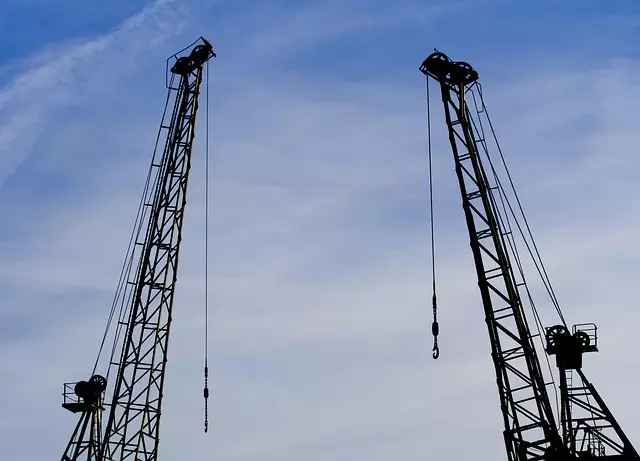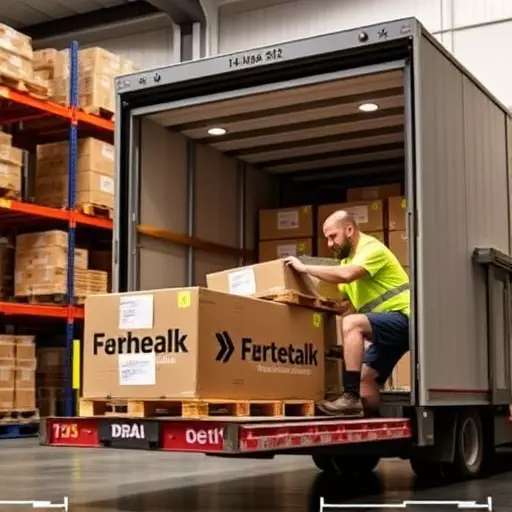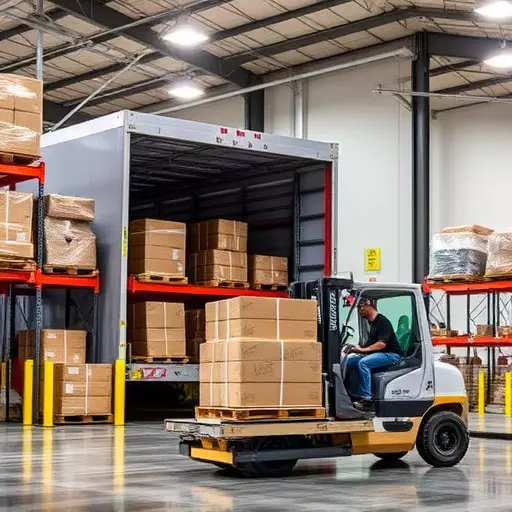Efficient warehouse operations in Holland, Ohio, focus on safe and streamlined loading/unloading processes using advanced technologies like AGVs and robotic arms. Best practices optimize productivity and worker safety during unloading, emphasizing adherence to safety protocols. These strategies enhance overall efficiency, contributing to a robust logistics hub while mitigating risks associated with handling goods within the facility.
“The future of efficient logistics is here, and it’s automated. In Holland, Ohio, the evolution of loading dock technology is reshaping the landscape of warehousing. This article explores the latest trends in loading and unloading services, from advanced safety measures to cutting-edge robotics. We delve into the impact of autonomous vehicles, the precision of robotic arms, and the integration of AI for streamlined warehouse operations. Discover how these innovations enhance efficiency, optimize processes, and prioritize worker protection in Holland’s thriving logistics sector.”
- Understanding Loading Dock Automation: The Current Landscape in Holland, Ohio
- Efficient Warehouse Loading Techniques: Streamlining the Process
- Unloading Safety Protocols: Ensuring Worker Protection and Equipment Integrity
- The Rise of Autonomous Vehicles: Transforming Loading and Unloading Operations
- Robotic Arms and Advanced Grabbers: Precision in Action
- Integrating AI and Machine Learning for Smart Logistics
- Future Trends: Predictive Analytics and the Internet of Things (IoT) in Warehousing
Understanding Loading Dock Automation: The Current Landscape in Holland, Ohio
Efficient Warehouse Loading Techniques: Streamlining the Process
Efficient Warehouse Loading Techniques streamline the process from arrival to dispatch, enhancing productivity and safety. At the core of this transformation are advanced technologies such as automated guided vehicles (AGVs) and robotic arms, which can precisely handle goods, minimizing damage and maximizing throughput. These innovations complement well-designed layout strategies, including optimized rack systems and strategic positioning of loading docks.
By implementing these warehouse loading techniques, businesses in Holland, Ohio, and beyond can significantly reduce labor costs, decrease errors, and improve overall efficiency. Unloading safety protocols, such as proper training for employees and the use of specialized equipment with safety features, are integral to this process. These measures ensure that operations run smoothly while keeping workers safe, contributing to a more robust and resilient logistics network.
Unloading Safety Protocols: Ensuring Worker Protection and Equipment Integrity
In the fast-paced world of logistics, efficient loading and unloading processes are paramount to success. However, these operations present significant risks for both workers and equipment if not properly managed. Implementing robust unloading safety protocols is non-negotiable in modern warehouse management, especially in regions like Holland, Ohio, where industrial practices are subject to stringent regulations.
Warehouse managers must prioritize worker protection by training personnel on safe handling procedures, ensuring clear communication, and providing adequate personal protective equipment (PPE). Simultaneously, maintaining the integrity of equipment, including forklifts, conveyors, and loading docks, is crucial to prevent accidents and prolong machine lifespan. By integrating advanced safety features like sensors, cameras, and automated systems, Holland, Ohio-based businesses can streamline unloading operations while adhering to stringent health and safety standards.
The Rise of Autonomous Vehicles: Transforming Loading and Unloading Operations
The rise of autonomous vehicles is a game-changer in the realm of loading and unloading operations, revolutionizing how warehouses and distribution centers manage their supply chain. These self-driving trucks and vehicles are equipped with advanced technology, including sensors, cameras, and AI algorithms, enabling them to navigate through tight spaces and perform tasks with precision. In the world of loading and unloading services Holland Ohio, this trend is transforming traditional methods into more efficient, safer, and cost-effective processes.
Autonomous vehicles offer several advantages for warehouse operations. They can significantly reduce labor costs by eliminating the need for human drivers, enhancing loading and unloading safety protocols in the process. These vehicles are capable of operating 24/7 without fatigue, ensuring continuous material movement. Additionally, their precise navigation allows for optimized routes within the warehouse, minimizing delays and maximizing productivity. As a result, businesses can expect improved overall equipment effectiveness and better management of inventory flow.
Robotic Arms and Advanced Grabbers: Precision in Action
Robotic arms and advanced grabbers are transforming the landscape of loading and unloading services in Holland, Ohio, and beyond. These precision tools excel in warehouse loading techniques, handling goods with meticulous care to prevent damage. With their multi-jointed designs and computer-aided vision systems, they can navigate complex spaces and grasp objects with unparalleled accuracy.
In terms of unloading safety protocols, robotic arms play a crucial role in mitigating risks associated with manual labor. They reduce the chance of workplace injuries by taking over repetitive and physically demanding tasks. By employing these advanced technologies, warehousing operations can become more efficient, safer, and faster, ultimately enhancing overall productivity and customer satisfaction in loading and unloading services.
Integrating AI and Machine Learning for Smart Logistics
The integration of Artificial Intelligence (AI) and Machine Learning (ML) is a significant trend in loading dock automation, revolutionizing warehouse logistics. By employing AI-driven systems, loading and unloading services in Holland, Ohio, can achieve unprecedented efficiency and accuracy. These technologies enable advanced process optimization by analyzing vast datasets related to warehouse operations, including inventory management, order fulfillment, and vehicle routing.
For instance, ML algorithms can predict optimal loading techniques for various cargo types, ensuring efficient use of space and faster processing times. Moreover, AI-powered systems enhance unloading safety protocols by identifying potential hazards and suggesting proactive measures, thereby reducing workplace accidents and improving overall operational safety in warehouses.
Future Trends: Predictive Analytics and the Internet of Things (IoT) in Warehousing
The future of loading dock automation is closely tied to advancements in technology, particularly predictive analytics and the Internet of Things (IoT). These innovations are transforming warehousing by optimizing warehouse loading techniques and unloading processes. Predictive analytics leverages data to anticipate demand patterns, enabling efficient scheduling of loading and unloading services in Holland, Ohio, and similar locations. By analyzing historical trends and real-time information, warehouses can streamline operations, reduce delays, and enhance overall productivity.
IoT devices, such as sensors and connected equipment, play a pivotal role in this evolution. They provide continuous monitoring of goods during loading and unloading, ensuring adherence to safety protocols. These smart technologies enable proactive maintenance, quick issue resolution, and better inventory management. As warehousing adopts these trends, the industry is set to witness enhanced efficiency, improved safety measures, and more responsive logistics, all crucial aspects for modern supply chain management.


